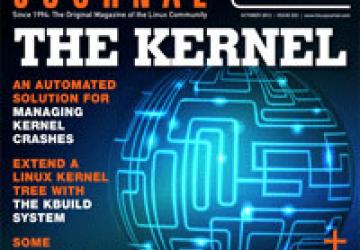October 2012 Issue of Linux Journal: The Kernel

The Seats Are Bolted Down
One of my favorite Linux kernel analogies is that of an airplane losing altitude. In the movies, when a plane suffers damage, the brave hero rips off the door and starts throwing things out in order to lighten the load. Suitcases fly, bags of peanuts scatter and anything not bolted down goes out in order to save the passengers. When a computer system gets old, or is low-powered to begin with, the Linux kernel can work the same way. Computers are so powerful now, we don't often think about removing kernel modules to gain speed, but not too many years ago, it was common to tweak our systems by stripping out unneeded or unused drivers. We seldom turn to our beloved kernel for speed increases anymore, but it's still the core of our OS. Most users don't think about the kernel, but then again, Linux Journal readers aren't most users. This month's issue is dedicated to the kernel. If that scares you off, fear not, we cover lots of other topics too.
Reuven M. Lerner starts off the issue with his take on switching to the Chrome browser. Like Reuven, I've been a Firefox user since before it was cool. About six months ago, I switched to Chrome too. This month, Reuven discusses how the switch went for him. Whether you're a Google fan, or think Google is horrible (or both), Chrome is a popular and viable browser. Now you get to see what a programmer thinks. Our other resident programmer, Dave Taylor, tackles another interesting challenge. Can there be a template for a bash script that is flexible enough to fill most needs, while providing a standard framework to facilitate best practices? If you've ever written a script knowing you should add more, but don't have the time to do it "right", Dave's article is for you.
Kyle Rankin writes about methods for deploying servers this month. Oh sure, that sounds like a basic tenant of system administration, but Kyle goes from the standard "insert CD and boot" method all the way to centralized configuration. If you're working in a corporate environment, chances are you don't have time to install servers one by one, and even if you do have time, it would be time wasted. Kyle's article might change the way you think about server installation, and more important, it might change the way you do it.
My contribution to the kernel issue is rather small. In fact, it will fit in your pocket. In my Open-Source Classroom column, I discuss the oft-confusing art of rooting an Android device. And, because rooting often is followed by installing custom ROMs, I cover that too. If you've ever wanted to try CyanogenMod on your phone, this month's article should be a big help. If you have an iPhone, well, feel free to read about what all the cool kids can do!
Javier Martinez Canillas starts off the nitty-gritty kernel articles with an introduction to kbuild. Like any other open-source project, the Linux kernel is the work of many people working together. Javier describes the system and shows how to add to the kernel. After reading an article on how to add to the kernel, I recommend a quick followup with Igor Ljubuncic and Raphael Sack's article on dealing with kernel crashes. An unstable kernel can go from bad to catastrophic quite quickly, so Igor and Raphael discuss how to automate the identification and handling of such events. Following their lead, hopefully your next kernel panic won't mean sysadmin panic as well.
Matt Davis also helps us deal with system problems at a low level using canaries. No, it's not just listening to their beautiful songs to soothe us. Rather, just like the miners of old using canaries to detect problems in a mine, a stack canary can detect system problems before any serious damage happens. If building safeguards into your code sounds like a good idea, or if you just want to read Matt's discussion of the Terminator Canary, you'll want to check out his article.
We finish the issue with a topic near and dear to my heart. Darren Douglas talks about teaching. I've been a professional Linux trainer for several years now, and Darren really drives home some important points regarding how we teach what we teach. Whether you're a trainer yourself looking for a gut check, or just an avid user desiring to share your knowledge with others, Darren really hits the target.
On the surface, this issue might sound intimidating to those folks who usually steer clear of the kernel. Thankfully, we do the hard work of tossing out the extra baggage so all you have left are those things bolted down and worth reading. Plus, we have plenty of other things—product announcements, tech tips and more—to keep you informed and entertained. So have a seat, put your trays in the upright position and enjoy this issue of Linux Journal.
Available to Subscribers: October 1










